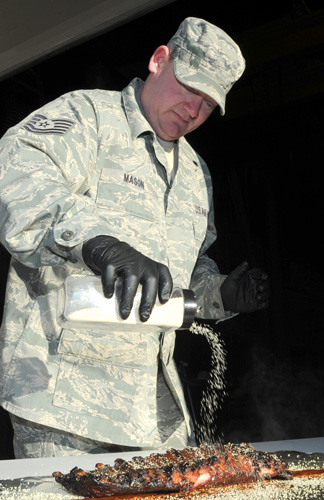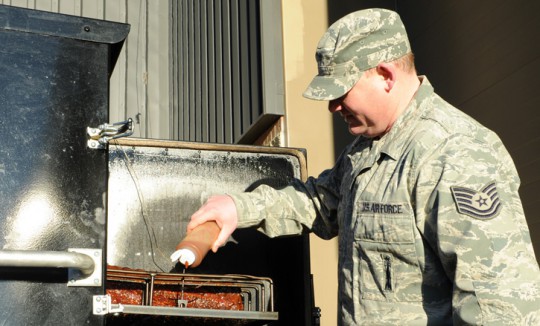Atmore Native Serving Up Authentic Air Force BBQ
January 12, 2014
When some people think of barbecue, they may imagine a simple hamburger thrown on a grill slathered in sauce on the Fourth of July. But for others, authentic barbecue is an extensive process that involves imported wood, secret ingredients, exact temperatures and up to 20 hours – all in hopes of perfecting the combined flavors of smoke, meat juices, spices and rub.
For Tech. Sgt. Sheldon Mason, 341st Maintenance Operations Squadron mechanical pneudraulics section assistant NCO in charge, perfecting barbecue is what the Atmore native does best.
“I started cooking when I was really young because my grandmother was a chef,” Mason said. “She didn’t really do barbecue as opposed to other cuisines, but I took to cooking at a young age.”
Mason has always been accustomed to large family gatherings of more than 100 people. But it wasn’t until his teenage years during these get-togethers when he learned “whole hog cooking,” that his love for barbecue took off.
“It’s just one of those things I’ve always wanted to do,” Mason said. “Within the past five years I’ve been able to get all the equipment I need to actually pursue this one day because barbecuing is really where my heart lies.”
Although Mason hails from the south in a place where barbecued pork is the food of choice, his specialty is beef brisket.
 “It’s funny because I’m a southern guy and I cook brisket, which is very popular in Texas,” he said. “It’s a little different to cook something that’s not from where you’re from, but I figured once I mastered brisket, which is one of the hardest things to cook, I felt like I could take on anything.”
“It’s funny because I’m a southern guy and I cook brisket, which is very popular in Texas,” he said. “It’s a little different to cook something that’s not from where you’re from, but I figured once I mastered brisket, which is one of the hardest things to cook, I felt like I could take on anything.”
Today, Mason uses a gravity-fed smoker for low and slow cooking, which can cook up to 200 pounds of meat. Through trial and error, he has perfected his sauces, cooking time and wood type in the past decade.
“Length [to cook] depends on what the meat is and the size,” Mason said. “Ribs can take anywhere from four to six hours and pulled pork and brisket can take upwards of 12 to 16 hours; but each one is temperamental so I just have to go by the feel and the color. It’s not an exact science – it’s something I’ve learned based on experienced.”
Mason says he aims to satisfy the taste buds of all barbecue lovers from various regions in the U.S.
“I try to cater to everyone,” Mason said. “I don’t have one particular style of barbecue but I put my own spin on it to try to hit all the regions. From the east coast, to the west coast, to the Carolinas and Kansas City, every region has a different flavor of barbecue sauce and specialty meat.”
As an NCO who’s spent 14 years at Montana’s Malmstrom Air Force Base in various maintenance sections, Mason is accustomed to working with and supervising Airmen of different backgrounds. Mason’s vision to stay true to regional barbecue calls for importing wood directly from various states.
“The wood infuses different flavors into the meat,” Mason said. “Wood reacts with the different types of rubs and the different meat used. In order to cook true barbecue, I import all of the wood – from California to Georgia to Washington to stay true to that type of barbecue.”
For hopeful or avid lovers of making their own barbecue, Mason has a few suggestions.
“As far as wood, never use pine,” he said. “Fruit woods add a sweet flavor to the meat; whereas woods like hickory and oak infuse strong flavors, so it’s important to be careful. Mixing those with sugars can create a very robust flavor. Some people don’t know that they don’t need as much smoke as they may think they need. Although [the meat] is smoked, it doesn’t need 12 to 15 hours of straight smoke because it’ll darken the meat too much. Depending on the kind of meat – pork, ribs or brisket – it needs just enough smoke to give it that smoked flavor because the heat is what gives it the true smoke flavor.”
Although Mason typically barbecues for 10 to 50 people, he hopes to one days cook for the masses.
“I’ve done squadron functions, going-aways, retirements – I’ve done a little bit of everything,” he said. “Anyone that requests barbecue usually comes to me. It doesn’t really matter what the occasion is; the more the merrier.”
While Mason intends to pursue barbecuing as a full-time career in the future, his current life as an active-duty Airman continues to be his number one priority.
“I currently plan on retiring at 20 years to pursue this venture, but anything could happen,” Mason said, adding that he plans to open a barbecue place in Great Falls, Montana.
Although creating a business is Mason’s ultimate goal, he finds satisfaction in simply bringing friends, family and Airmen together on the principles he was raised on.
“Honestly, I think food is what brings people together,” he said. “Food, to me, is something everyone can relate to because everyone has to eat. The time it takes to barbecue is something a lot of people don’t understand because it takes such a long time to make this sort of food. It’s a simple food, but it’s not a simple science. Not a lot of people do this because it’s very time consuming and I’m very particular about how I make it. But I really enjoy doing it and that’s why I truly do it; that’s the passion I have.”
Pictured top: Tech. Sgt. Sheldon Mason of Atmore, 341st Maintenance Operations Squadron, pours barbecue sauce on ribs during an office lunch on Montanta’s Malmstrom Air Force Base. Pictured inset: Mason seasons his barbecue ribs. Photos by Senior Airman Katrina Heikkinen for NorthEscambia.com, click to enlarge.




Comments